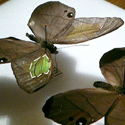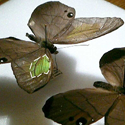Reverse rainbows shine light on butterfly behavior
The wings of even the plainest butterflies can be the setting for a spectacular light show. Unlike their more stereotypically beautiful cousins, the wings of Pierella luna butterflies are a superficially drab brown, to blend in with plant debris and the forest floor of their native environment. The males of this species, however, have iridescent forewings that show other colors when illuminated at specific angles. When the forewings are illuminated along the axis from the body to the wing tip, a white beam of light decomposes like it would from a diffraction grating, except for a surprising difference: the color sequence for Pierella luna male butterfly wings is the reverse of the expected rainbow spectrum, with violet emerging at the lowest angle, and other colors from blue to red appearing at larger angles to the wing plane.
In a paper published in Physical Review E, Jean Pol Vigneron of the University of Namur in Belgium and collaborators at the Smithsonian Tropical Research Institute in Panama, show that this counterintuitive effect is caused by a macroscopic deformation of the wing scale, the curling of which yields an effective “vertical transmission grating” perpendicular to the wing scale. It is an open question what the biological significance of the reverse spectrum is, but the fact that it is unique to male Pierella luna leads one to speculate that it might play a role in courtship rituals or territorial struggles with other males. – Daniel Ucko





